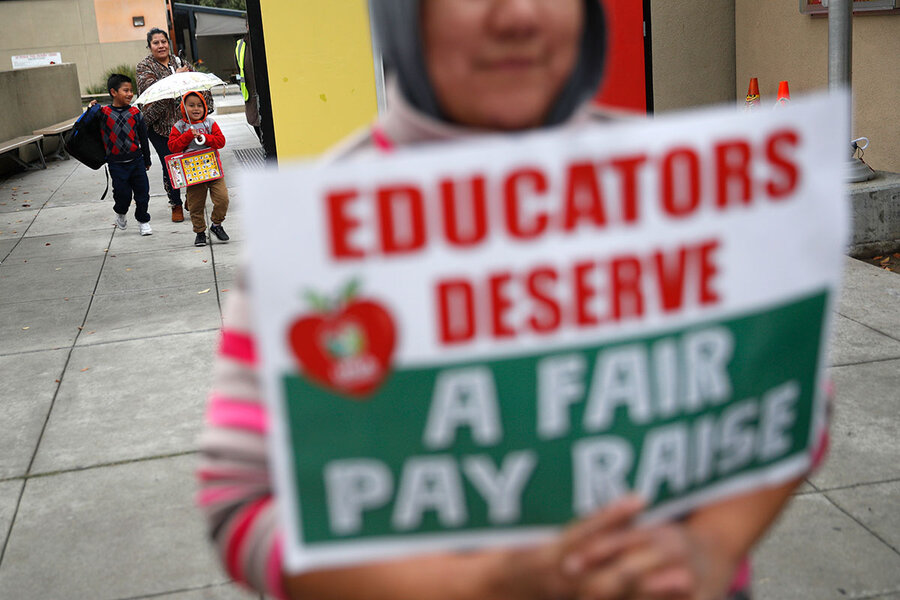Behind LA teachers strike, a ‘battle for the soul’ of public education
Loading...
| Sacramento, Calif.
The ongoing strike organized by United Teachers Los Angeles has seen more than 30,000 teachers walk off the job in the country’s second-largest school district. The union has called for higher teacher salaries, smaller classes, and more support staff, but the standoff also reflects a broader struggle over the privatization of public schools. Some 120,000 students in Los Angeles, or 1 in 5, attend charter schools, which are privately operated and receive $550 million a year from the district. Analysts regard the walkout as a potential bellwether for teachers unions elsewhere. “If it’s successful, other unions could again see strikes as a viable tactic for generating more momentum for the public school system as a whole,” says Bradley Marianno, an expert on teacher unions. Austin Beutner, the district’s superintendent, has rejected the union’s framing of the strike as a referendum on charter schools. But following last year’s Red for Ed campaign, which involved teachers in several predominantly Republican states staging protests and winning concessions from lawmakers, the UTLA strike could influence the country’s education debate. Says John Rogers, an education professor at UCLA, “The union leaders in L.A. have been buoyed by the Red For Ed movement, but they view this as much more than a labor dispute.”
Why We Wrote This
In addition to questions about class size and pay, at the heart of a teachers strike in Los Angeles is a clash over what public education is actually supposed to do: provide an equality of opportunity or aim for an equality of outcomes.
More than 30,000 public school teachers in Los Angeles began a strike Monday that marked the first time they had walked off the job since 1989. One year after that last strike, Michele Levin started teaching in the country’s second-largest school district. Over the decades, she has watched class sizes swell, resources dwindle, and the frustration of her colleagues reach a crescendo.
“There’s always tension between management and the teachers,” says Ms. Levin, who teaches health and science at Daniel Webster Middle School on the city’s west side. The school lacks a full-time librarian or nurse, and she has spent $1,500 of her own money to buy notebooks, pencils, and other supplies for students. “But at this point, the district’s actions feel like an attack on the institution of public education. It’s time to draw a line in the sand.”
Her criticism echoes the broader concern of teachers in the Los Angeles Unified School District (LAUSD), who beyond practical demands for higher salaries, smaller classes, and more support staff, want to slow the effort to privatize operation of public schools – or stop it outright.
Why We Wrote This
In addition to questions about class size and pay, at the heart of a teachers strike in Los Angeles is a clash over what public education is actually supposed to do: provide an equality of opportunity or aim for an equality of outcomes.
Union and district representatives offer competing visions of the purpose of public education in the US: one a more traditional version that nurtures all students, the other embracing more experimentation in search of better models of teaching, with the school serving as a laboratory. Above that is an ideological question that extends beyond California: Is the purpose of education to provide an equality of opportunity or to aim for an equality of outcomes?
For their part, district officials say that it’s simply not possible to pay for all the teachers’ demands. LAUSD Superintendent Austin Beutner has sought to allay the concerns of teachers while advocating for providing students and parents with a choice of schools. In a TV interview last week, he noted that if “it’s the flexibility of charter schools that’s allowing them to excel, let’s bring that flexibility into the traditional school classroom.”
In a district with 600,000 students – 80 percent of whom live at or below the poverty line – the United Teachers Los Angeles (UTLA) asserts that the expansion of charter schools poses an existential threat to students and teachers alike. The union’s president, Alex Caputo-Pearl, emphasized that point at a press conference Sunday when he declared, “We’re in a battle for the soul of public education.”
Since 2006, the number of charter schools in Los Angeles has jumped by more than 150 percent to 277, the most of any district nationwide. Some 120,000 students, or 1 in 5, attend charter schools, which are privately operated but receive public tax dollars – in this case, $550 million a year from LAUSD.
Two years ago, charter-school advocacy groups backed by billionaire donors – including Reed Hastings, the CEO of Netflix, and the Walton Family Foundation, a nonprofit created by Walmart’s founders – spent $15 million to elect a pro-charter majority to the Los Angeles Board of Education.
The district’s recent history and sheer size make the standoff a potential bellwether for teachers unions elsewhere. Similar strikes loom in Denver; Oakland, Calif.; Richmond, Va.; and other cities amid a growing push by education reformers to privatize the operation of public schools.
“The UTLA strike could have a big impact,” says Bradley Marianno, an assistant professor of educational policy and leadership at the University of Nevada, Las Vegas, and an expert on teachers unions. “If it’s successful, other unions could again see strikes as a viable tactic for generating more momentum for the public school system as a whole. People are watching.”
More than a labor dispute
Teachers in Los Angeles took to the picket lines this week after more than a year of failed negotiations between union and district leaders over a new contract. The UTLA has called on the district to tap a $1.9 billion surplus to increase teacher salaries and hire more school librarians, nurses, and psychologists.
The union has rejected counteroffers from LAUSD officials, who insist that dipping into the reserve fund could prove ruinous for the district in light of dire budget projections.
The walkout in Los Angeles follows last year’s Red for Ed campaign that saw teachers in several predominantly Republican states, from Oklahoma to West Virginia, stage protests over low pay and education funding cuts that trace to the Great Recession. Their efforts won concessions from state lawmakers and, perhaps as important, boosted public support for teachers across the country.
Despite its blue-state status and pro-teacher climate, California, by one measure, ranks in the bottom 10 among all states in per-pupil spending for K-12 public schools. In that sense, UTLA’s demand for more state funding mirrors the Red for Ed crusade. But analysts suggest that the union’s fight against charter schools distinguishes its cause and could portend a shift in the national education debate.
“The union leaders in L.A. have been buoyed by the Red For Ed movement, but they view this as much more than a labor dispute,” says John Rogers, director of the Institute for Democracy, Education, and Access at the University of California, Los Angeles.
“In light of financial and enrollment pressures that have been partly brought on by the growth of charter schools, they see a chance to make the case that what students and parents need are more robust public schools.”
School funding in Los Angeles depends on student enrollment, and the soaring number of children attending charter schools has drawn money away from traditional public schools. Union leaders claim that the reduced funding has impeded traditional public schools from hiring more teachers, resulting in larger class sizes.
David and Shirley Ashe’s daughter attends eighth grade at Marina Del Rey Middle School. She complains to them that her learning suffers as teachers struggle to control disruptive students in classes with 30 to 40 children.
The Ashes say teachers at the school and other parents confirm the problems. The couple have hired an education coach at a cost of $400 a month to meet with their daughter twice a week to supplement her classwork and prepare her for high school and college.
“For us, the overwhelming issue is class size,” says Mr. Ashe, a web project manager. He and his wife support the strike. From their perspective, the district has nurtured charter schools at the expense of schools like Marina Del Rey. “It’s a disservice to students, it’s a disservice to teachers, and it’s a disservice to parents,” he says. “There’s a lot of frustration.”
Patch of common ground
The Los Angeles school board selected Mr. Beutner to serve as LAUSD superintendent last year after he gained the support of the panel’s pro-charter majority. A former investment banker and deputy mayor of the city, Beutner, who lacked professional experience in school administration before taking the position, has dismissed as “baseless” the union’s framing of the strike as a referendum on charter schools.
Beutner and Mr. Caputo-Pearl, the union president, agree that an increase in state funding would ease the district’s dilemma. California Gov. Gavin Newsom, who took office earlier this month, unveiled a proposed state budget last week that included a record $80.7 billion for K-12 and community college education. Another $3 billion for teacher pensions would reduce the fiscal burden on districts across California.
Yet even with the district and UTLA finding a patch of common ground on state funding, the chances of the two sides bridging their ideological rift appears small, according to Pedro Noguera, director of UCLA’s Center for the Transformation of Schools.
“The disagreement over charter schools is still going to be there after the strike,” he says. “That’s something that will continue to be an issue because there isn’t a long-term solution to the district’s financial difficulties.”
Only about a quarter of the district’s students attended class Monday, and district officials estimated that the low turnout for a single day cost LAUSD about $15 million in future state funding. The mounting tab could intensify pressure on the union to settle if public opinion begins to sour.
“There is always concern about whether the public and parents will support a strike of teachers, especially when parents depend on the schools to care for their children while they are at work,” says Lois Weiner, a professor at New Jersey City University and an independent researcher on teachers unions.
For Ms. Levin, who has taught middle school in Los Angeles for almost 30 years, the support of parents and students during the first days of the strike has reaffirmed her conviction that LAUSD has lost its way.
“I’ve never thought about leaving teaching,” she says. “But I have thought about leaving this district because it feels like our superintendent and our school board don’t like public schools and don’t like teachers. They’re abandoning us and they’re abandoning our students.”








